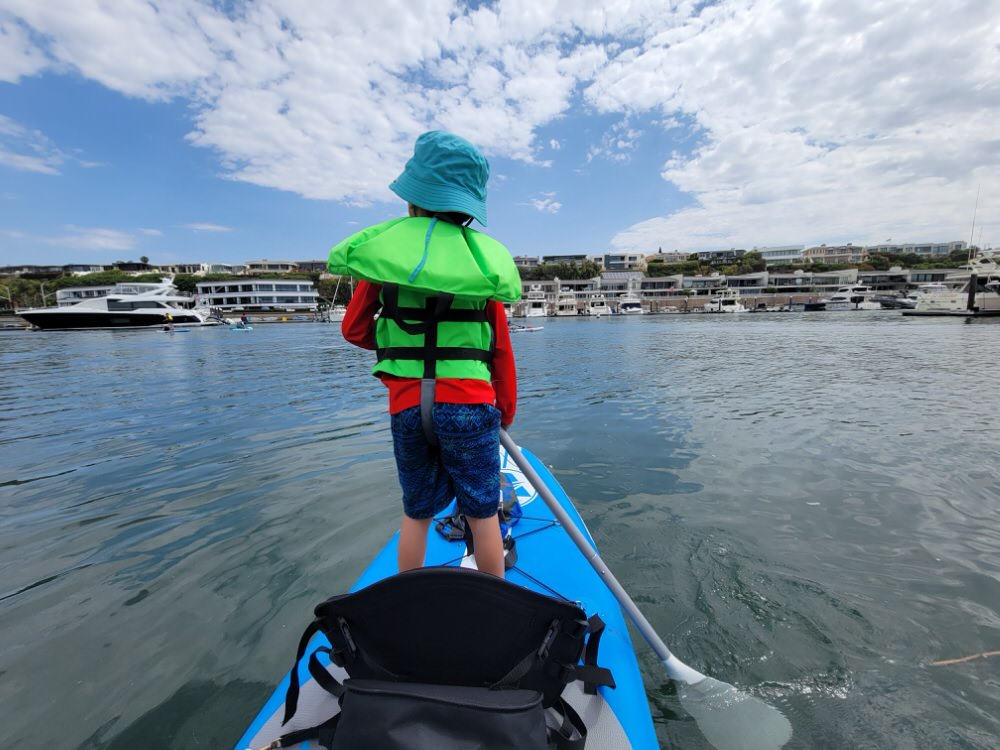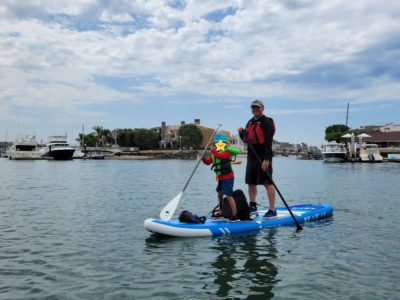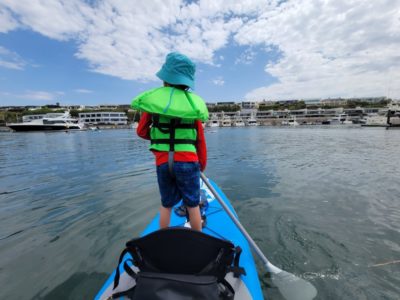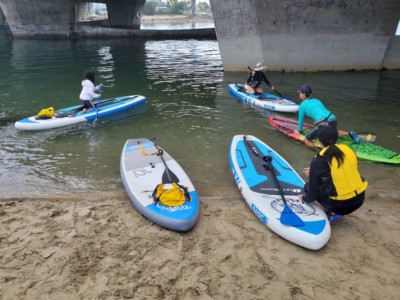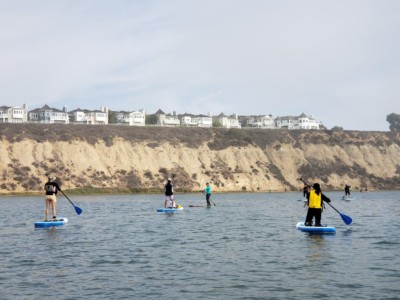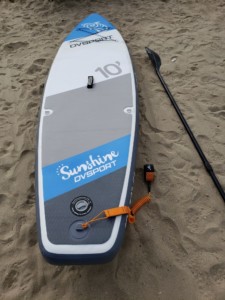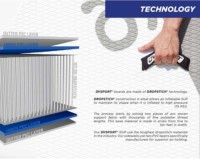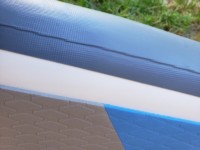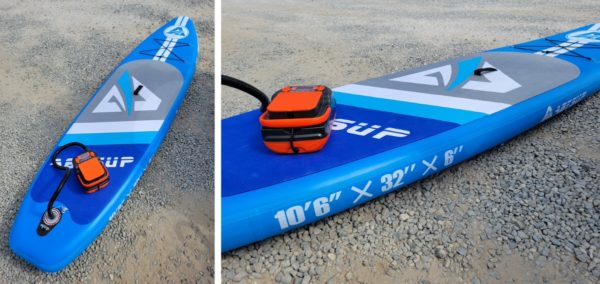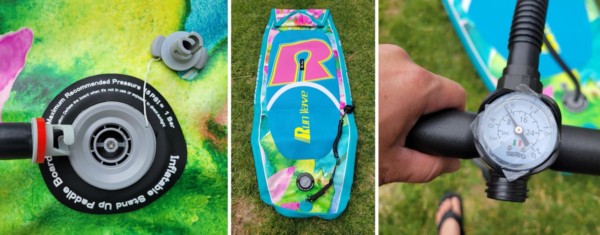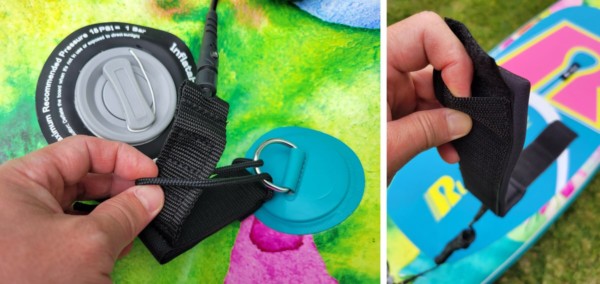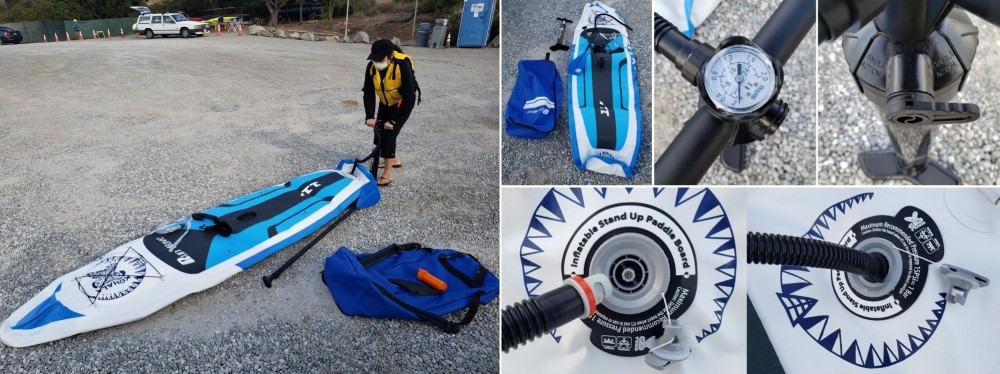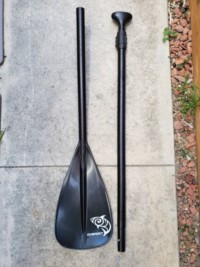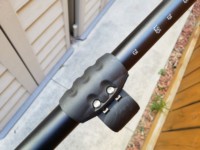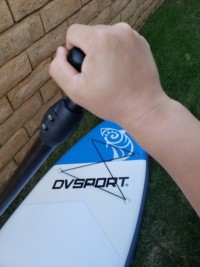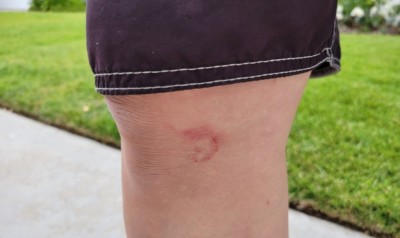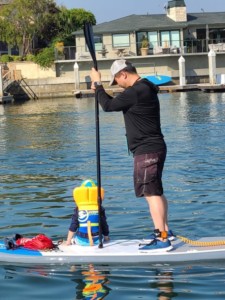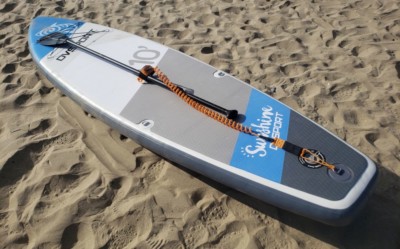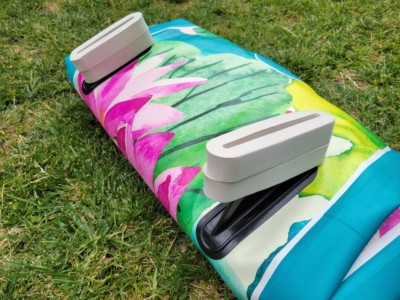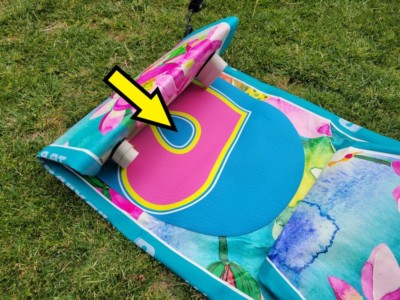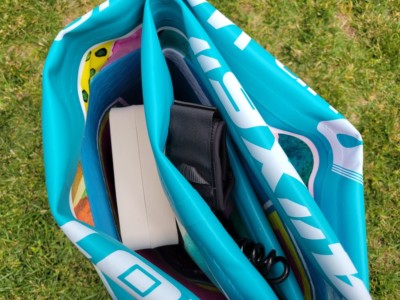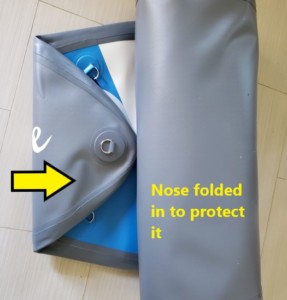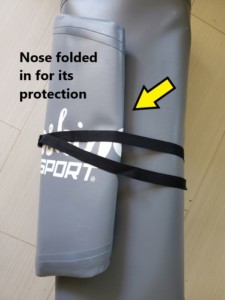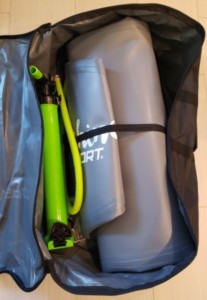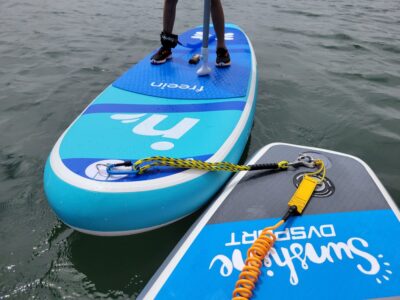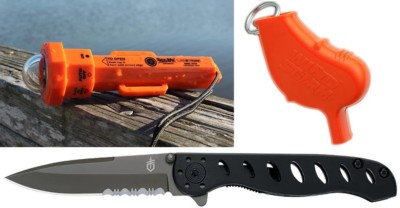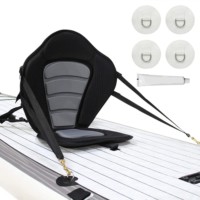Contents
iSUP Basics and Tips
Stand up paddle boards have seen an increase in popularity over kayaks, particularly in Southern California. They provide freedom to roam around, are easy to transport and store, and are a lot of fun! We had received many questions from friends, family, and acquaintances about inflatable stand up paddle boards (iSUP) in particular, and this article will go over some basics and provide useful tips to make the most out of them.
We urge you to learn the basics to minimize injury, get more enjoyment out of your iSUP, and be familiar with how to choose and maintain your board so it will last longer.
Choosing a Board
Solid vs Inflatable
Which is better? It depends on what type of activity you want to use one for although the differences between them are narrowing. Here are the pros and cons of Inflatable SUPs.
iSUP Pros
- Less expensive
- Lighter than hard boards (ie. epoxy)
- Takes up less space in its deflated state
- Easier to transport and can fit in a small car
- Can be checked in on an airplane and helps save on rental fees
Inflatable SUPs are more durable than hard boards as they won’t scratch or ding when dropped, making them a bit more suitable for rocky, wild adventures.
- Causes less injuries than hard boards
- More durable than hard boards as they won’t scratch or ding when dropped, making them a bit more suitable for rocky, wild adventures
- Hard boards are more prone to cracking, scratches, and holes appearing that require immediate fixing
- Extra volume adds more stability and support for more weight
- Recreational boards can accommodate paddlers with up to 300+ lbs total
- Can last 10+ years, depending on maintenance, storage environment, and other factors
iSUP Cons
- Takes time to inflate or deflate
- Hard boards are ready to go and require little to no preparation
- Requires a pump
- Inflating a paddleboard to 12-15 PSI (about 1 Bar) takes quite a workout. Electric pumps are available (see “Where To Buy” section below for recommendations)
- Does not perform as well or as fast as hard boards, making them not as good for racing competitions, though the performance gap between SUPs and iSUPs is narrowing
- Puncture resistant but not puncture-proof
Tip: You can turn nearly any SUP/iSUP into a Kayak. See our guide: How To Add D-Rings to Convert an iSUP into a Kayak. It is easier than you may think.
Ideal Board Size
The following are general guidelines on how to select the right board. I am not a professional SUP rider and suggest you visit a paddle board shop for advice tailored to you.
- Width: The wider a board, the more stability is added (useful for beginners or tandem riders) but harder to paddle
- 31″ and wider are perfect for beginners and tandem riders
- 30″ or narrower, due to less drag on the board, increase mobility and speed, suitable for surfing
- Length: The longer a board, like snowboards, the more streamlined it is to cover distance
- 12′ and longer are designed for racing
- 9′ – 11′ are great for recreation
- 9′ or less are intended for surfing due to more nimble mobility
- Children iSUPs are also shorter
Guide: How to Safely Paddle Board with Kids – See our tips and tricks that worked for our family and friends.
- Thickness: The thicker a board, the heavier of a rider it could carry
- 5″ or thicker are best
- 4″ are perfect for children and light paddlers
It is better to be too light than too heavy for a board
- Volume: The higher volume of a board (measured in Liters), the more weight and height of a rider it can accommodate due to increased buoyancy, and be more stable
- Choose a board that is at or below the suggested weight limit
- Going above the weight capacity can introduce a sinking drag and be harder to paddle on
- Take into consideration
- Overall weight, including any food, water, gear, and companions
- Your skill level and age
- Water environment and activity type
- Check out a SUP Volume Calculator (1 kg = 2.2 lbs)
- Not all boards with the same volume are the same. Their concavity and overall shape, among other factors, affect a board’s performance
- Beginners: Total weight x (1.1 to 1.4)
- If you are 170 lbs and plan to bring a 50 lb child with 10 lbs of food and water, total weight is 230 lbs. Volume should be between 253L – 322L
- Intermediate or Advanced: Total weight x (0.9 to 1.1)
- It is better to be too light than too heavy for a board
- 200L and up are generally great for recreation and beginners
- Choose a board that is at or below the suggested weight limit
Keep in mind that after a few times of paddling, you may find yourself quickly advancing in your abilities. My personal recommendation with anything I do is to always get something that is at least a notch above my current skill level.
Board Construction
There are different iSUP construction types and each affects durability, stability, and cost. Knowing which one to choose can be quite confusing.
Single Layer
Consists of a single layer of construction.
- Lowest price / Lightweight
- Lowest maximum supported rider weight
- Not as durable / Flexes a bit
Dual Layer: Glued
Original construction method that combines two single layers.
- Pricier than single layer / Heavier
- More durable / Good performance
- Stiffer, increasing stability
Dual Layer: Laminated
Latest, dual layer technology that improves over the glued, dual layer construction method.
- Higher price / More durable / Better performance
- Lightweight, but heavier than both single-layer and glued dual-layer
- Higher maximum supported rider weight
- Stiffer, increasing stability
Getting Ready to Paddle
Here is what you need to check before you take your board out to paddle.
Board Preparation
- Ensure the valve is clean and free of dust and debris
- Warning: Many boards require the valve to be in the UP position when inflating. If you leave it DOWN, you will lose a LOT of air pressure the moment you disconnect the pump
- Inflate the iSUP to between 13-15 PSI (15 PSI is best)
- Warning: Do NOT go over 15 PSI with most iSUPs!
- If the board will be left in the hot sun, inflate to only 12-13 PSI. The heat will increase the internal pressure, and pumping the board to only 13 PSI will help ensure it will not expand past 15 PSI
- In general, inflatable SUPs should be inflated to 15-17 PSI (no more than the rated max), even if the manufacturer states that it can go as high as 25 PSI
- If using an electric pump, inflate to 12-14 PSI, and hand pump the rest to 15 PSI (unless you trust the accuracy of the electric pump’s pressure gauge)
- Do NOT use an air compressor as it could easily overinflate
- Double-check board pressure before heading out
- Before first use, leave the board inflated for a day and see if it loses pressure. If it does, refer to the manual on how to find the leak
- Leaving board in the sun/heat can increase pressure, and in the cold can have pressure decreased
A safety leash is NECESSARY to help keep the board attached to you. Not having one could separate the board from you by the wind or stream, forcing you to swim all the way back to shore. A leash can SAVE YOUR LIFE!
- You should always have a safety leash
- Attach ankle cuff to the less dominant leg and the other end to the loop at the tail of the board
- Keeps board close to you when you fall into the water and prevents any waves or wind from pushing it away
- Remember to attach any necessary fin(s) to the bottom of the board
- Do not drag paddle boards across the pavement as that can puncture and damage
- Carry the board by the center handle instead. Lift board onto its side with the handle facing away from you (bottom of board faces you), and grab the handle to lift the iSUP off the ground
Paddle Preparation
Like whitewater rafting and kayaking, the proper grip, angle, and length will make for a more enjoyable experience.
- Length: Adjust paddle shaft about 7-10″ above your height
- When your arm is fully stretched out with paddle flat and close to your body, your 90-degree bent wrist should rest over the top of the handle
- Hand positions
- Place one hand on TOP of the handle. This helps minimize injury to yourself and others and maximizes efficiency
- Raise both elbows up to shoulder height and arms bent at a 90 degree angle
- The length from one elbow to the other is where the other hand should hold the paddle shaft
- Paddle blade: Should be curved towards the nose of the board for better efficiency
- Blade is angled forward, away from you
How to Paddle
- When entering the water, ensure the fin(s) of the board have fully cleared the sand and are entirely in the water
- Ensure a SUP safety leash is attached to your ankle and the tail of the board so you won’t get separated from the board. It could SAVE YOUR LIFE!
- Wear (not just carry) a personal flotation device (PFD)/life jacket, if required, though strongly recommended
- Check the laws of your Country and State, especially regarding children. See our guide: How To Choose A Life Vest For Kayaking, Paddle Boarding
- Kneel with your body centered over the board (where the board handle is) and paddle away from the shore
- Before standing up, put the paddle horizontally across the board in front of you (do not let it go)
- With the body in a dog position, stand up around where your knees were (one leg at a time). Keep legs spread apart
- Stay there for a moment until you have a better feel and find yourself to be stable
- Unlike snowboarding, have knees and chest face forward while paddling
- Stand straight and look forward, not down, for better balance
- Practice your balance while standing before you start paddling
- Ensure paddle blade is angled forward and away from you
- In other words, when looking at the blade from its side, the smaller angle from the shaft to the end of the blade should be facing forward
- Starting from the front of the board, place whole blade under water and pull it back CLOSELY along the iSUP until it is near your feet
- Keep entire blade under the water when pulling. Having it partially above water will waste energy
- If you find yourself about to fall, land in the water (not onto the board) to avoid injuring yourself or damaging the board
- Do not fall feet first as you could get yourself injured on corals and rocks. Try to land flat
- The board itself can be rock hard due to the amount of pressure it contains. I had bruised and even cut myself falling onto the board
More Paddle Tips
- Getting back onto the board more easily
- After a fall, go to the tail side and place both hands on each side of the board
- While pulling yourself back up on your stomach, kick with your feet behind you (not under the board) to help propel your upper body onto the board (like a seal)
- Once you get better, you may try to climb back onto the board from the side of the board
- Place one hand onto the center carry handle, and as you propel your upper body onto the board with your feet, have the other hand grab the other side of the board
For added stability, especially when waters are rough, place the paddle (with handle down) in front of you to form a tripod. Bend your knees as necessary to lower your center of gravity
- If you need to push yourself away from something, gently do so with the handle pointed at it to minimize injury to other persons and/or damage to the property
- Blade is more dangerous and damaging than the handle
- To move up or down the board, scoot/jump forward/backward with both legs at the same time (don’t walk)
- When you get better, a few of the fun things I like to do is to jump and turn 360 degrees without losing balance, and to perform a step-back turn which requires quite a lot of balance
After Paddling
I have found that after paddle boarding, putting away the iSUP into the car can be a pain, especially when the ground is full of sand. The following steps help me put the board away quickly and simply without dirt:
- While still in the water, secure the paddle blade into the front netting (handle portion should be near the board’s center carry handle)
- Attach the leash to paddle’s handle
- Pick up iSUP sideways off the water by the center carry handle (with it facing away from you) and ensure no part touches the ground/sand
- Your hand should be able to carry the board, paddle, and leash all from the center carry handle
- This also leaves your other hand available to hold anything else needed
- Leave the iSUP leaning against your car to let any remaining water drip away
- If board was used in saltwater, you may consider spraying it down with fresh water
- A garden spray hose works perfectly for that and for washing hands and sandy feet
- Wipe off any sand and water
- Remove the large fin from the board
- Secure the leash to the middle carry handle so it won’t fall onto the sand
- If board was used in saltwater, you may consider spraying it down with fresh water
- Move the board into the trunk (front first) or onto tarp on the ground
- Open the valve to let air out and start folding the iSUP (from the tail end) into the trunk
- Warning: Do NOT look directly from above the valve! The released air pressure will be very strong and could blow debris into your eyes!
- Clear out any sand, debris, or water around the valve
- Not doing so could cause damage to the valve and introduce leaks
- Once home, hose down the board with fresh water
- Let it dry completely so mildew does not build up
- Follow the steps under the “Storage” section to put the iSUP away
Storage
- There is no need to deflate an inflatable board for storage
- If storing outdoors, raise it off the ground (but do not hang), and cover it with a tarp
- Only use mild soap and fresh (not salt) water to clean
- Deflating the iSUP
- Hose down the board with fresh (not salt) water, and let it dry completely so mildew does not build up
- Clear out any sand, debris, or water around the valve
- Not doing so could cause damage to the valve and introduce leaks
-
- Some boards ask to start folding from the tail side, but that could leave some air behind. This is the process I follow instead:
- Fold from the nose side until all the air has been squeezed out, then close the valve
- Unfold the board and start folding from the tail side, paying attention to the fins and ensuring they are protected
- Do not fold too tightly or you’ll put unnecessary stress onto the seams that could eventually result in leaks
- Towards the end, tuck in the nose and finish folding. This will help protect the nose
- Strap the folded board to keep it from unrolling
- Some boards ask to start folding from the tail side, but that could leave some air behind. This is the process I follow instead:
- Store away from direct sunlight and extreme temperatures
- Avoid environments that can go above 150F (66C) (such as garages) or below -10F (-23C)
- I do store mine in the garage since it almost never reaches those temperatures
- Keep the iSUP in its included storage bag, if one was provided
Safety Considerations
- Dress appropriately for where you are boarding
- Hypothermia can kill within minutes
- Considering wearing a life vest
- Be aware of your surrounding and stay away from boats and motorized vehicles
- Note that paddling back upstream or against the wind will be quite tiring. If you do find yourself struggling against the wind, here are some tips to follow. The key is to provide less wind resistance:
- Position yourself closer to the front of the board so its nose points down more
- Kneel down
- If all else fails, go on your stomach, place the paddle underneath you, and paddle with your hands
- Note that paddling back upstream or against the wind will be quite tiring. If you do find yourself struggling against the wind, here are some tips to follow. The key is to provide less wind resistance:
- Don’t go paddling when it looks like it could rain or lightning is approaching
- For emergency, I pack the following:
- Whistle: Koala Windstorm (if used on saltwater, metal can corrode over time and so I replaced the lanyard with a strong rope instead)
- Strobe: ust See-Me 2.0 (so rescuers can find you more easily)
- Knife: Gerber EVO Jr. (in case I get caught on something. Attaches to my Onyx life vest)
- Tether: Dolibest Tow Rope (to more easily tow another board without bungee effect)
Tip: Have an emergency whistle and strobe with you in case you need help or need to signal a boat that is about to ram you.
- You should let a trusted contact know where you are going, who you will be with, what you will be wearing, and when you expect to return
- You should always paddle with at least another person
- Wear a life vest, especially when heading out into the ocean
- Don’t just BRING one and attach it to the front net… WEAR it. It could save your life!
- When wearing sunglasses, be sure to have a strap attached to them
- A friend and I each lost our Oakley sunglasses the moment we fell into the water
Life Vests
Life Jackets are essential for your safety and can even be required by law. See our guide on Personal Flotation Devices (PFD): How To Choose A Life Vest For Kayaking, Paddle Boarding.
How To Safely Paddle with Kids
Parents have asked us: “How do you get your children comfortable with water and start paddle boarding?”
Guide: How to Safely Paddle Board with Kids – See our tips and tricks that worked for our family and friends.
Conversion to Kayak
Adding a seat is a VERY nice way of converting a stand up paddle board (whether inflatable or not) into a relaxing, single or tandem-seated kayak. All you need are four (4) D-Rings affixed to the iSUP that you attach the seat onto.
Guide: How To Add D-Rings to Convert an iSUP into a Kayak. It is easier than you may think.
A Kayak Conversion Kit can be purchased (like the South Bay Kayak Kit that includes 4 D-Rings and PVC glue). Molded, foam seats provide better comfort.
Where To Buy
- Emergency Accessories
- Whistle: Koala Windstorm | Strobe: ust See-Me 2.0 | Knife: Gerber EVO Jr.
- Accessories
- Electric iSUP Pumps
- Battery Built-In: Dr. Meter / Furein / BeWellAero (Heavy-duty and fast)
- 12V Cigarette Plug: Samengd / Vachan
- Garden Spray Hose for rinsing off
- Dolibest Tow Rope (to more easily tow another board without bungee effect)
- iSUP Safety Leash | Oceanbroad SUP/Kayak Paddle | YYST Paddle Holder Clip
- Electric iSUP Pumps
- Life Vests
- See our guide: How To Choose A Life Vest For Kayaking, Paddle Boarding
Related Posts
- How-To Guides:
- Reviews: Inflatable Stand Up Paddle Board
- Freein Kids 8′ (2022): Made specifically for children and light adults
- DvSport Sunshine: One of my favorites. A bit more advanced, dual-layer iSUP
- Runwave Kohala: Less expensive, single layer iSUP board that many of my friends have recommended. It is a best-selling beginner board
- Runwave Lotus Flower: Very light, dual layer iSUP with a colorful, flower-inspired art design. It is a tad more stable than the Runwave Kohala
- Abysup SUP123: Dual layer, lighter iSUP that is slightly more advanced than the Runwave Kohala

